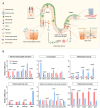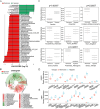Neonatal hypoxia leads to impaired intestinal function and changes in the composition and metabolism of its microbiota
- PMID: 40312410
- PMCID: PMC12045951
- DOI: 10.1038/s41598-025-00041-2
Neonatal hypoxia leads to impaired intestinal function and changes in the composition and metabolism of its microbiota
Abstract
Neonatal hypoxia, a prevalent complication during the perinatal period, poses a serious threat to the health of newborns. The intestine, as one of the most metabolically active organs under stress conditions, is particularly vulnerable and susceptible to hypoxic injury. Using a neonatal hypoxic mouse model, we systematically investigated hypoxia-induced intestinal barrier damage and underlying mechanisms. Hypoxia caused significant structural abnormalities in the ileum and distal colon of neonatal mice, including increased numbers of F4/80+ cells (p = 0.0031), swollen mucus particles (p = 0.0119), and disrupted tight junction. At the genetic level, hypoxia caused dysregulation of the expression of genes involved in intestinal barrier function, including antimicrobial activity, immune response, intestinal motility, and nutrient absorption. Further 16 S rDNA sequencing revealed hypoxia-driven gut microbiota dysbiosis with general reduced microbial abundance and diversity (Chao1 = 0.1143, Shannon = 0.0571, and Simpson = 0.3429). Structural dysbiosis of the gut microbiota consequently perturbed metabolic homeostasis, especially enhancing the activity of glycolipid metabolism. Notably, results showed that hypoxia may interfere with neurotransmitter metabolism, thereby increasing the risk of neurological disorders.
Keywords: Gut microbiota; Intestinal barrier; Intestinal dysfunction; Mice; Neonatal hypoxia.
© 2025. The Author(s).
Conflict of interest statement
Declarations. Competing interests: The authors declare no competing interests. Ethics approval and consent to participate: This study is performed in accordance with relevant guidelines and regulations. All methods are reported in accordance with ARRIVE guidelines.
Figures





Similar articles
-
Gut microbial dysbiosis exacerbates long-term cognitive impairments by promoting intestinal dysfunction and neuroinflammation following neonatal hypoxia-ischemia.Gut Microbes. 2025 Dec;17(1):2471015. doi: 10.1080/19490976.2025.2471015. Epub 2025 Feb 26. Gut Microbes. 2025. PMID: 40008452 Free PMC article.
-
High-fat diet intake modulates maternal intestinal adaptations to pregnancy and results in placental hypoxia, as well as altered fetal gut barrier proteins and immune markers.J Physiol. 2019 Jun;597(12):3029-3051. doi: 10.1113/JP277353. Epub 2019 May 13. J Physiol. 2019. PMID: 31081119
-
27-Hydroxycholesterol contributes to cognitive deficits in APP/PS1 transgenic mice through microbiota dysbiosis and intestinal barrier dysfunction.J Neuroinflammation. 2020 Jun 27;17(1):199. doi: 10.1186/s12974-020-01873-7. J Neuroinflammation. 2020. PMID: 32593306 Free PMC article.
-
Oxygen battle in the gut: Hypoxia and hypoxia-inducible factors in metabolic and inflammatory responses in the intestine.J Biol Chem. 2020 Jul 24;295(30):10493-10505. doi: 10.1074/jbc.REV120.011188. Epub 2020 Jun 5. J Biol Chem. 2020. PMID: 32503843 Free PMC article. Review.
-
Mechanisms and consequences of intestinal dysbiosis.Cell Mol Life Sci. 2017 Aug;74(16):2959-2977. doi: 10.1007/s00018-017-2509-x. Epub 2017 Mar 28. Cell Mol Life Sci. 2017. PMID: 28352996 Free PMC article. Review.
References
-
- Graham, E. M. et al. A systematic review of the role of intrapartum hypoxia-ischemia in the causation of neonatal encephalopathy. Am. J. Obstet. Gynecol.199, 587–595. 10.1016/j.ajog.2008.06.094 (2008). - PubMed
-
- Yeh, C. et al. Neonatal dexamethasone treatment exacerbates Hypoxia/Ischemia-Induced white matter injury. Mol. Neurobiol.54, 7083–7095. 10.1007/s12035-016-0241-4 (2017). - PubMed
-
- Greco, P. et al. Pathophysiology of hypoxic-ischemic encephalopathy: a review of the past and a view on the future. Acta Neurol. Belg.120, 277–288. 10.1007/s13760-020-01308-3 (2020). - PubMed
MeSH terms
Grants and funding
LinkOut - more resources
Full Text Sources

